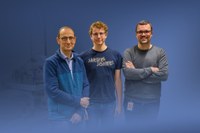NARILIS and LIBST researchers unravel a mechanotransduction pathway induced by nanoscale membrane deformations
Prof. Henri-François Renard (UNamur, NARILIS), together with his long-time collaborator Prof. Pierre Morsomme (UCLouvain, LIBST), focuses on fundamental mechanisms governing the dynamic remodelling of cell membranes, in particular during endocytosis. He is particularly interested in the role of BAR (Bin/Amphiphysin/Rvs) domain proteins, which are key players in the detection/induction of membrane curvature.
The UNamur-UCLouvain collaboration has recently come up with major findings, which have just been published in the journal Science Advances (Ledoux et al., 2023). In this work, the researchers demonstrate how BAR proteins play a pivotal mechanotransductional role as “signaling hubs”.
The scientist who carried out the experimental work and first author of the study is Dr. Benjamin Ledoux, a former PhD student at UCLouvain in Pierre Morsomme’s laboratory and now research logistician at the UNamur Morph-Im (bio-imaging) platform. During his PhD thesis, Benjamin developed homemade fluorescent nanostructured substrates to artificially induce nanoscale plasma membrane deformations ranging from 100 to 500 nm in living cells. Using this approach in combination with high-resolution microscopy, he showed that distinct subsets of BAR proteins are recruited in the environment of these deformations in a membrane curvature radius–dependent manner. The study further details how BAR proteins mediate specific downstream cellular responses depending on the plasma membrane geometry.
These data are highly relevant in a physiopathological context, as dysfunctions in some BAR domain proteins have been linked to genetic and neurodegenerative disorders, or cancers. These findings may also be key for the design of biocompatible materials for example.
This work is also the fruit of a broader collaboration with UCLouvain teams (Prof. David Alsteens, NanoBiophysics lab and Prof. Christine Dupont-Gillain, Institute of Condensed Matter and Nanosciences), as well as the Universities of Geneva in Switzerland and Gyeongsang in South Korea.
Contact: benjamin.ledoux@unamur.be and henri-francois.renard@unamur.be
Crédit photo: Christophe Swijsen
From left to right: Pierre Morsomme, Benjamin Ledoux and Henri-François Renard
 NAmur Research Institute for LIfe Sciences
NAmur Research Institute for LIfe Sciences


